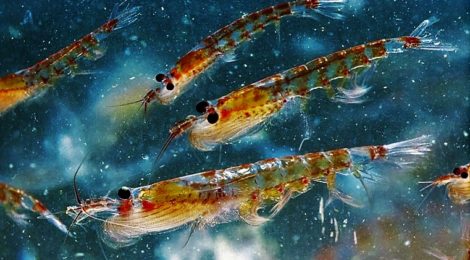
Krill Reveal Their Work To Keep Ocean Pastures Flourishing
Once again the miracle of life reveals that there are no ‘free loaders’ in Nature
Tiny zooplankton like krill that graze on ocean pastures evolved the ability to keep minuscule amounts of vital mineral iron arriving in their world in good supply to sustain their pasture.
What legions of krill cannot do is solve is the terrible drought of mineral dust that is decimating ocean pastures. What we can do is help with the dusting.
Yet another group of scientists are reporting that Antarctic krill – a tiny shrimp-like crustacean – plays a vital role in fertilizing the Southern Ocean with iron. The iron they, and countless other zooplankton, scavenge and intentionally recycle stimulates the growth of phytoplankton, the microscopic plants that are the grass of their ocean pasture. This finding provides a monumental scale leverage effect in the oceans’ capacity to capture CO2 and repurpose it into life itself.
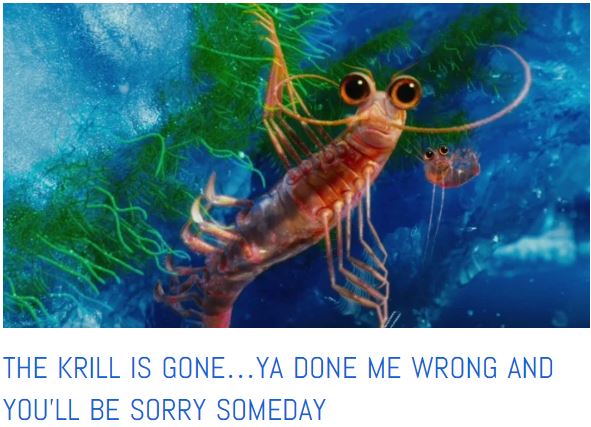
All is not well with the Krill and their kind as vital dust for their ocean suffers decades of drought – click to read more
Reporting this month in the journal Current Biology, a team of European researchers describe how iron-rich mineral dust particles that are carried to oceans of the world on the wind are dissolved in the acidic guts of zooplankton. There that iron which is the most vital nutrient for the ocean pastures of this blue planet that contain the vast majority of life on Earth.
Iron is always the most limited vital plant nutrient, where scarce it is found in ocean water at concentrations of just a few parts per trillion. Even when in abundance the concentration will still be less than a part per billion. While some might refer to it as a ‘fertilizer’ like nitrates, levels of nitrate fertilizers and ordinarily a million times more. Iron is a true trace element.
Being in such short supply it Krill continually scavenge it and reprocess and deliver it back to the phytoplankton. It appears Krill are not mere feeders, they are farmers who tend the grass of the most extensive and vital pastures on our planet. The new details in this report offer important knowledge in understanding key processes in the most biologically rich regions of our planet.
The research team found that tiny mineral particles mostly from wind-blown dust but also from sediments washed in from rivers that ordinarily might rapidly sink to the sea-bed like the rocks that they are instead are actively scavenged and eaten by krill. Within their acidic guts, iron that might sink and be lost is freed from these particles and is then strategically released in dissolved form into the surface ocean. Krill have a characteristic behavior where they stay in the dark deep waters beneath their ocean pasture plankton blooms during the day to avoid being seen and eaten by predators. In the dark abyss they peacefully digest like cows chewing their cud under the shade of a tree.
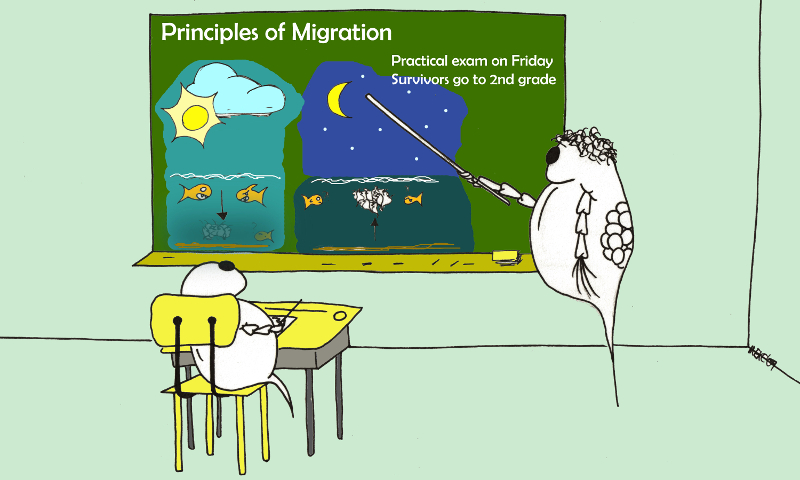
Diel migration is very basic learning for all young plankton… ‘Fish that want to eat you will do so if they can see you!’ Stay deep unless it is nightime. – click to read more
Each night krill swim hundreds of meters to the surface where in the dark of night they can graze in safety on the phytoplankton of their ocean pasture. They’ve brought with them a gut full of iron rich compost, aka krill poo, that they spread in the surface water as super-charged plant food with bio-available iron that stimulates and sustains the pasture plankton blooming as the sun rises.
The krill in turn are a key part of the ocean food chain sought out by all manner of larger organisms including fish, seabirds, penguins, and whales, all of ocean life is dependent on the health and abundance of their ocean pasture. One of the new tidbits from this study reveals how krill also produce iron-binding chemicals (called ligands) that prevent the iron from re-attaching onto particles and therefore sinking into the depths of the ocean where it is unavailable to stimulate and sustain photosynthesis.
This powerful and ultra-efficient natural iron nutrient supply stimulates the growth of phytoplankton – the tiny plants that bloom in the ice-free surface waters during the Antarctic summer and form the base of the Southern Ocean food web. This process also enhances the Southern Ocean’s capacity for natural storage of carbon dioxide. It is known that for every single atom of iron made available to catalyze photosynthesis 1 million molecules of CO2 is repurposed into new ocean life, of that about 25% sinks to the bottom.
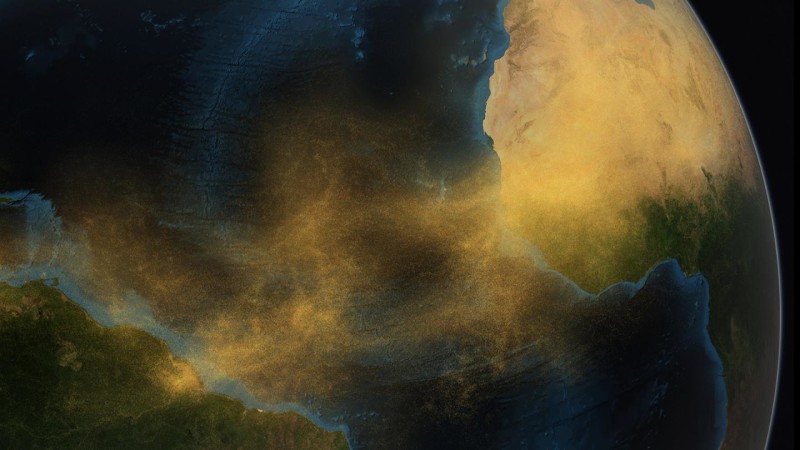
Each year hundreds of millions of tonnes of dust blows out of Sub-Sahara Africa heading west across the Atlantic. Most of that which lands in the ocean quickly sinks out of the growing zone and offers scant nutrient support for ocean pasture blooms. – click to read more
Iron is an essential element for life, but large parts of the world’s oceans experience limited iron concentrations. Land-derived particles such as fine grains of dirt and rock that come as windblown dust and river discharges are a potential source of iron for the ocean, but the vast majority is insoluble and sinks to the ocean bed.
It is well-known that krill can recycle iron that is already incorporated in biological matter, but this is the first time that anyone has found that their ability goes beyond recycling. This ability to convert iron into a vital micro-nutrient solution that boosts coastal and ocean waters changes our view of how the ocean might respond to future change.
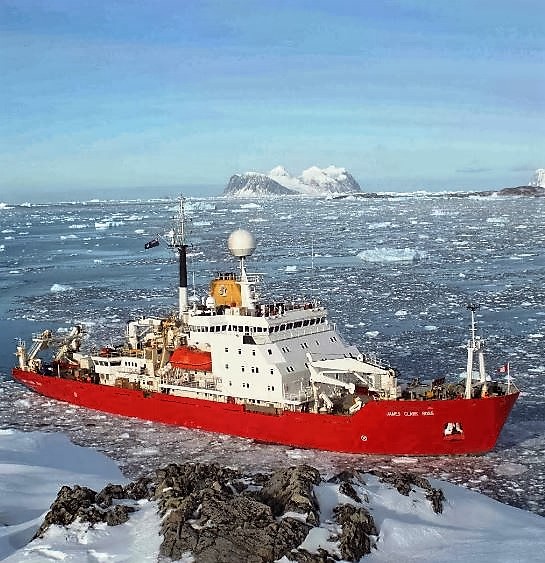
British research ship James Clark near Antarctica
The team analysed data from a research cruise on the BAS-operated Research Ship James Clark Ross around the sub-Antarctic island of South Georgia during 2010/2011. Phytoplankton blooms downstream of South Georgia were more intensive and longer lasting when there was a high abundance of krill.
“For this study we examined krill but it is very likely that other ocean filter-feeders such as salps, copepods and mysids may share this iron-dissolving mechanism.” According to co-author Sophie Fielding.
“This finding is essential for understanding the ocean’s capacity for carbon capture. As atmospheric carbon dioxide levels increase, it’s essential for us to understand both the physical and biological mechanisms for sustaining the ocean with iron.”
The newly identified powerful leverage effect of Krill in their highly efficient management of ocean iron helps to explain the long-standing apparent enigma of how so little iron can have such an enormously powerful and lasting effect in ocean pasture ecosystems. It now is clear “life needed to find a way to deal with the paucity of iron and so it did.”








